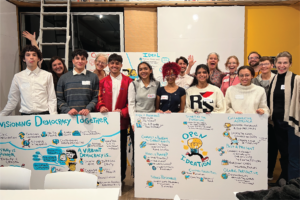Dan Norton: Filament Games

Founding partner and lead designer of Filament Games Dan Norton spent some time with me on the phone last week to talk about gaming, game design, and its incorporation into public education.
The company, based in Wisconsin, is actually on a roll. They are currently putting finishing touches on a few new games. One of them, interestingly, is a game about geology and identifying minerals. Another is something called “Roots of Our Government.” Says Norton: “You design your own government and put it against the tests of time to see what happens.”
After playing one of the Filament Game best-sellers, “Resilient Planet,” I asked Norton if he could explain why in playing the game I didn’t feel like I was experiencing a prototypical education game — tick the box, hewn so close to learning objectives that it only seems to be about the objectives, and not fun, and not realistic. Norton explained that it was because the learning objectives are the first test for any game, but the real work goes into making the game consisten with the verbs and the learning styles that create knowledge and understanding.
“We as, ‘What are the things we want someone to know or demonstrate by the time they learn or master the game?’ We then go about creating an identity and a set of verbs…to identify the game based tasks,” says Norton. Where other game developers fall short, and create “unfeeling” kind of games, is in the startup process. Norton says: “Some of them just copy a commercially successful game.”
I subscribe to the idea that there are different types of learning styles. You’ll find that students will be drawn to different types of activities. It’s an extra trick for games. We don’t want to make games that are only games for gamers. You can’t make books in school for only a limited portion of the audience. We can’t assume our products can work only for hard core gamers. We have to make our games broad enough to have broad appeal.
That is a fascinating aspect of educational gaming. Where the gaming marketing in the United States is huge — Flash-based games alone have 87 million users online — it’s easy to make a “broadly appealing” game that hits that very large demographic. But gaming in education is different. Gaming has to be focused on the learning styles, the classroom objectives, the teacher ease of use, and the culture being pitched to.
Having this kind of mindset will make a game developer successful, and understanding this differentiation and an increasing focus on personalization is what’s going to make gaming successful to the “new curriculum.
Norton also says that it’s not likely that gaming can address all the objectives of something like the new Core Curriculum. And that’s because games are specific to certain types of learning and thinking. He made a good point at the end of our conversation when he said that if you take this approach of making online fit every core objective, you end up with a problem of relating to the online software. Games are only good for really specific types of thinking: negotiating and forming an identity; problem-solving collaboratively; thinking cyclically about specific objectives; and and understanding the structure of a system.
Where these objectives are important, gaming will play a crucial role. Where they are not, there are plenty of other ways to teach and other tools to use to get to great teaching. Gaming is a piece of the very complex puzzle of establishing a new system for excellence in education.








0 Comments
Leave a Comment
Your email address will not be published. All fields are required.